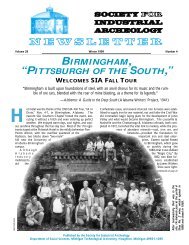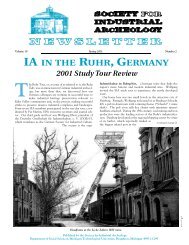SIAN - Society for Industrial Archeology
SIAN - Society for Industrial Archeology
SIAN - Society for Industrial Archeology
You also want an ePaper? Increase the reach of your titles
YUMPU automatically turns print PDFs into web optimized ePapers that Google loves.
No visit to Milwaukee would be complete<br />
without breweries and beer. The<br />
Thursday afternoon tour was led by Susan<br />
Appel, historian of brewery architecture.<br />
The tour began with a brief stop at the Cpt.<br />
Frederick Pabst Mansion, the last of many<br />
grand houses that used to line Milwaukee<br />
Ave. Adjacent to the 1889 mansion is the<br />
Pabst Pavilion from the 1893 Columbian<br />
Exposition, converted to a chapel in the<br />
mid-20th century after the Archdiocese of<br />
Milwaukee acquired the property.<br />
We proceeded two miles west, making<br />
our way into Miller Valley, home of the<br />
city’s last major brewery. Here along<br />
State Street stand 76 buildings on 82<br />
acres including a modern reproduction of<br />
the c.1850 Plank Road Brewery facade,<br />
meant to portray the place that Frederick<br />
Miller bought from the sons of Jacob Best<br />
in 1855. Our “hardhat” tour included the brew house with<br />
its picturesque lauter tuns and brew kettles, the packaging<br />
and keg line, filtration and utilities along with the Miller<br />
Valley Brewery (pilot plant), and one of the old caves that<br />
was used to store lager in the 19th c. In addition, the group<br />
sampled Lite and High Life. It was quite refreshing.<br />
Next we headed back east on Highland Avenue toward the<br />
vast Pabst Brewery complex, passing homes of two Pabst sons<br />
on the north side of the avenue. Driving into the Pabst site at<br />
8th and Juneau, we were struck by the scale of the property,<br />
MILWAUKEE (continued from page 5)<br />
Breweries, Breweries, Breweries<br />
are sold under the names of Simplicity and Snapper with<br />
engines by Kohler, Briggs & Stratton (Simplicity’s new parent<br />
company), Honda, and others.<br />
Decommissioned in 1903, the Port Washington Light<br />
Station is owned by the city and being restored by the Port<br />
Washington Historical <strong>Society</strong>. The current 1860 building<br />
with integrated house and tower is built of cream-city brick<br />
with a light 132-ft. above Lake Michigan. Recent restoration<br />
includes the participation of the Grand Duchy of<br />
Luxembourg. Yes, around 2000, in recognition of the many<br />
immigrants from Luxembourg who settled in this area in the<br />
mid-19th c., and in gratitude <strong>for</strong> the liberation of<br />
Luxembourg during WWII, the tower and light were reconstructed<br />
in Luxembourg and ceremoniously brought to Port<br />
Washington <strong>for</strong> installation.<br />
Just down the bluff from the light station is the Port<br />
Washington Power Plant. We saw the demolition of the<br />
<strong>for</strong>mer coal-fired plant, built in the 1930s, juxtaposed<br />
against the construction of the new natural gas-fired plant,<br />
just going online. The reuse of the site made sense: the<br />
transmission lines were in place; Lake Michigan was there<br />
<strong>for</strong> cooling water <strong>for</strong> the steam cycle and to chill air <strong>for</strong> the<br />
<strong>Society</strong> <strong>for</strong> <strong>Industrial</strong> <strong>Archeology</strong> Newsletter, Vol.34, No. 3, 2005<br />
Kettles at the Pabst brew house.<br />
which, when compared to Miller, had many<br />
more 19th-c. buildings and fewer modern<br />
intrusions. Our tour guide, Jim Haertel,<br />
explained the redevelopment plans that<br />
un<strong>for</strong>tunately include tearing down all but 10<br />
of the 28 buildings. After sampling from a<br />
variety of the Pabst products now brewed by<br />
Miller (Pabst, Jacob Best, Schlitz, etc.), which<br />
were good, we got back on the bus and headed<br />
north past smaller <strong>for</strong>mer breweries including<br />
the E. L. Husting Brewery (Vliet and<br />
5th) and the Obermann Brewery (Cherry<br />
and 5th). Along the way, we also saw the<br />
Water St. Brewery, a modern micro-brewer<br />
and the <strong>for</strong>mer Blatz Brewing Co.<br />
On our way to the Lakefront Brewery,<br />
we passed through Schlitz Park seeing the<br />
adaptive reuse of the old bottling building,<br />
the 1890 brew house, and the <strong>for</strong>mer Schlitz<br />
Stables, now United Way offices. Lakefront<br />
is a microbrewery (no more than 15,000 barrels a year).<br />
Den we gotta sample some gutt biers. An’ the guy that<br />
showed us aroun’ was a real hoot. He took us into the back<br />
an’ showed us where an’ how dey make da bier usin’ da 1516<br />
German Purity Law. I tink dat der primary fermentation<br />
tanks were painted liek da 3 stooges! We drank some more<br />
bier and den we wen’ back to da hotel an’ da reception. Lets<br />
hear it <strong>for</strong> da brewers!<br />
David Wohlwill<br />
Dan Bonenberger<br />
combustion turbines; and the local community was accustomed<br />
to having a major power plant in their midst.<br />
North of Milwaukee is the small town of Saukville, home of<br />
Charter Steel. Still headed by a member of the founding<br />
Mellowes family, the company produces a wide range of steel<br />
wire and rod in diameters between 7/32 in. and 1-3/8 in. We<br />
learned that the difference between ‘wire’ and ‘rod’ varies in<br />
the industry. At Charter, a rod is finished in the roll mill, while<br />
wire is drawn through a die. Charter’s raw material is scrap<br />
steel, which is melted in electric-arc furnaces. The molten<br />
steel’s composition is adjusted by means of additives such as<br />
manganese and then is transferred by ladle to the continuous<br />
caster. It puts out billets that are cut into pieces weighing 4,400<br />
lbs. One by one, the billets enter the roll mill, a long series of<br />
waist-high roll stands that gradually shape and lengthen the<br />
billets into the desired diameter and cross section. The end of<br />
the process is a winding machine that coils the finished product,<br />
resulting in a long row of steel coils that glow a dull red and<br />
fade to gray as they cool. Charter has about 600 employees and<br />
produces 700,000 tons of finished products yearly that end up<br />
in items as diverse as guitar and piano strings, automobile oil<br />
dipsticks, and Flexible Flyer sled runners.<br />
(continued on page 9)<br />
7






